
Jakh Botera, Jakhdada, Jakkha Bautera, 72 Yaksha or Bohter Yaksha , literally seventy-two Yaksha warriors, are group of folk deities worshiped widely in Kutch district of Gujarat, India.

Jakh Botera, Jakhdada, Jakkha Bautera, 72 Yaksha or Bohter Yaksha , literally seventy-two Yaksha warriors, are group of folk deities worshiped widely in Kutch district of Gujarat, India.


The Jakhs said to were shipwrecked on the Kutch coast and came ashore at place, now known as Jakhau. Variously described as tall and fair-complected with an advanced culture, their traditional number is seventy-two with at least one woman. Their origins are obscure. [1] [2]
The legend associates Jakhs with historical town of Punvaranogadh, the ruins are located about two miles to the north-west of present-day village of Manjal, Kutch district, Gujarat. [3]
Punvaranogadh was built around 878 by Punvar, son of Ghaa or Ghav, the chief of Kera, Kutch and possibly a nephew of Lakho Phulani. Quarreling with his family, Punvar or Punrao resolved to found a city and call it after his own name. When the city was finished, the architect was rewarded by having both his hands chopped off that he might not do work like it for any one else. Soon after, seven devotees of Jakhs renowned for their virtues and miracles came from Rum-Sham (possibly Anatolia and Syria or Byzantine), and settled in a high hill near Punvaranogadh. Hearing of their fame, Punvar's childless queen had an underground passage dug from the palace to the devotees' hill. Helping them in the service of their god Jakh, she after six months prayed them to ask the god to give her a son. But, for her husband's sins, until a sacrifice was offered in the palace, the prayer could not be granted. By the underground passage the holy men entered the palace and were performing their rites when Punvar, hearing there were strange men in the women's rooms, forced his way in, seized the devotees, and set them with bare feet to tread out corn in a threshing floor bristling with harrow-spikes. Pitying their sufferings a friendly barber named Babra offered to take the place of one of them. The freed devotee went to the top of Lakhadiya hill nearby and call Jakhs to their aid. Jakhs heard the prayer, and, with an earthquake that shook the hills, appeared with seventy-one brothers and a sister, Sayari or Sairi. Called on to give up the holy men, Punvar refused and by the help of the gods and a magic amulet suffered nothing from the arrows of Jakhs. Then Sayari, taking the form of a mosquito, bit Punvar on the arm so that he drew of his amulet, and, in the siege, a stone falling from the roof broke his head. Jakhs cursed the town and it has since lain desolate. Later Jakhs were revered by people and the temples were erected in their dedication. [3] [4] [5] [6]
Another story is that in the eighth century; king Punvar oppressing the Sanghar community, they sought the aid of Jakhs. Seventy-two Jakhs came, and, establishing themselves on a hill three miles from Punvaranogadh, took the fort and killed the chief. The Sanghars named this hill Kakkadgadh or Kakkadbhit in honour of the strange leader Kakkad, and, out of respect for the saviours, called them Yakshas or Jakhs after the fair-skinned horse-riding demigods, Yaksha. In their honour the Sanghars made images of the seventy-two horsemen, set them on a railed platform on Punvaranogadh with their faces towards the south and started annual fair dedicated to them. [3] [5]
Another story suggested that they were healers who traveled on horseback, helped poor and considered messenger of God. Due to their influence of people, Punvar disliked and killed them all. The temple was erected at Kakkadbhit to commemorate their sacrifice. [7]
Several of the hills near get their names from their quaking before Jakhs; Nanao, "the sinker"; Dhrabvo, the shaker ; Lakhadiyo, unstable as water ; Addho Chini, the eleft[ check spelling ]. Another hill was called Kakadbhit after the youngest of the seventy-two Jakhs. [3] [8]

Yaksha, a term later corrupted into Jakh, of Kutch has obscure origin but are agreed as a historical figures. They are described as superhuman beings, white, handsome, and mounted on horseback. According to popular view, Jakhs were of either Hindu or Arab origin. The social and religious customs and practices of Sanghars, the followers of Jakhs, are a mixture of Hindu and Islamic ones. [5] Fair horsemen from the west, the fact that their traces remain only on the coast would seem to show that they came by sea. This excludes from the number of possible Jakhs, the Greeks, the Indo-Scythianss, and the White Huns who all came from land routes. There remain the Romans of the first, the Persians of the sixth, and the Arabs of the eighth centuries. The Romans may be rejected. Their invasion is doubtful and they could hardly have brought horses. Arabs too seem unlikely. They would strike the Kutch people as ruddy not as white, and, by their conquest of Sindh and their attacks on western India, the Arabs were too well known to become centres of legend. It therefore seems probable that these Yakshas were the Persians who, at that time the chief seafaring nation in the Indian seas, in the sixth century, conquered the lower Indus, but did not settle withdrawing as soon as the local ruler agreed to pay tribute. The Indo-Sassanian coins recovered in 1830 also associate them with Persian origin. [3]
Sometimes they are associated with Europeans due to reference of fair skin. [4] Rushbrook Williams, an English historian, in his book The Black Hills of Kutch suggested that the Jakhs may be Zoroastrian who while fleeing Persia might have shipwrecked on the coast of Kutch. Another theory suggest that they belonged to Byzantine or Assyria. [2] [6] [7] The Persian Sassanid kings had association with Jacobites or Nestorians which might have landed in Kutch. [5] [9]
The names are listed in a poem associated with legend. In 18th century, Hamirji Gadhvi, the court-poet of Rao Deshalji II of Cutch State, was asked by Deshalji to find the all names of Jakhs. He miraculously received the names of Jakhs on the Lanki hill close to Sinduri stepwell near Bharapar village on the way to Kera from Bhuj. Hamirji doubted that the Rao would consider his list as forgery. When he prayed the Jakhs and presented the list in court, the Jakhs appeared in the sky, one after another. The temple was built at the place where they appeared near the court which is known as Jakhjarna in Bhuj. The shrine was also built by Hamirji on the Lanki hill ( 23°10′18″N69°38′17″E / 23.1716295°N 69.6380945°E ) where they had given him names. [10] [8]
They are as follows: [8]

Their idols are presented as the Jakh warrior mounted on the horse. They are presented in group with idols, generally seventy two, in varying size and shapes.
The temple shrines dedicated to Jakhs are known as Thada locally. The major temple dedicated to them is erected on a small hillock of Kakadbhit, located on highway few kilometers from Manjal, which is about 35 kilometers from Bhuj. [11] Several other temples are construed across Kutch and beyond by their followers including Sanghar community. Saint Mekan Dada and the ruler of former Cutch State, Deshalji II construed temples in their dedication.

The fair dedicated to Jakhs, Jakh Botera no Melo or Mota Jakh no Melo, is organised on the second Monday of Bhadrapad (September–October) every year on the foothills of Kakadbhit. This fair lasting two to three days is attended by thousands of pilgrims, mostly Kutch Hindus. [3] [4] [5] [7] It is considered one of the largest fair of Kutch. Other fair known Nana Yakshno Melo is organized every year near Bhuj.[ citation needed ]

Kutch district, officially spelled Kachchh, is a district of Gujarat state in western India, with its headquarters (capital) at Bhuj. Covering an area of 45,674 km2, it is the largest district of India. The area of Kutch is larger than the entire area of other Indian states like Haryana (44,212 km2) and Kerala (38,863 km2), as well as the country of Estonia (45,335 km2). The population of Kutch is about 2,092,371. It has 10 talukas, 939 villages and 6 municipalities. The Kutch district is home to the Kutchi people who speak the Kutchi language.

Bhuj is a city and the headquarters of Kutch district in the Indian state of Gujarat.
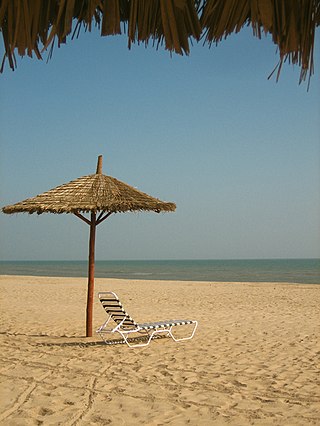
Mandvi is a beach town with municipality in the Kachchh district (Kutch) in the Indian state of Gujarat. It was once a major port of the region and summer retreat for Maharao (king) of the Cutch State. The old city was enclosed in the fort wall and remains of the fort wall can still be seen. The city has a four-hundred-year-old ship building industry which is still functional and dhows, a type of wooden ship, are still made. Mandvi Municipality's 36 Seat Of 9 Ward.
Nakhatrana is a city and headquarters for a taluka in the middle of Kutch (kachchh), Gujarat, in India.
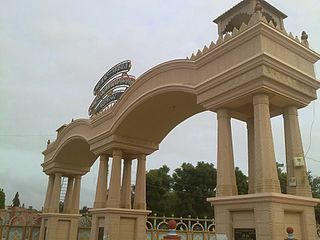
Madhapar is a village located in Kachchh district
Jakhau is a village in Gujarat, western India. Administratively, it is under Abdasa Taluka, Kutch District, of Gujarat. Jakhau is 17 km by road west-southwest of Naliya, the taluka headquarters. Jakhau Salt, the port of Jakhau, is situated a further 15 km westwards.

Koteshwar is a small village and the location of an ancient Shiva temple. It located near the mouth of Kori Creek, in the west of Kutch district of Gujarat, India.

Narayan Sarovar or Narayansar is a village and place of pilgrimage for Hindus on the Kori Creek. It is located in Lakhpat taluka of Kutch district in the Indian state of Gujarat. The ancient Koteshwar temple lies 4 km away, towards the north-west. The temple is classified among the 108 Abhimana Kshethram of Vaishnavate tradition.

Mata no Madh is a village in Lakhpat Taluka of Kutch district, Gujarat, India. The village lies surrounded by hills on both banks of a small stream and has a temple dedicated to Ashapura Mata, the household deity of former Jadeja rulers of kutch State. She is also considered patron deity of Kutch. The village is located about 105 km from Bhuj, the headquarters of Kutch district.
Alfred High School in Bhuj, Kutch is one of the oldest educational institution of Gujarat and first high school of Kutch. It was founded by Rao of Cutch, Pragmalji II in year 1870 at cost of ₹150,000 (US$1,800). The school was named Alfred High School, after Prince Alfred, the Duke of Edinburgh.
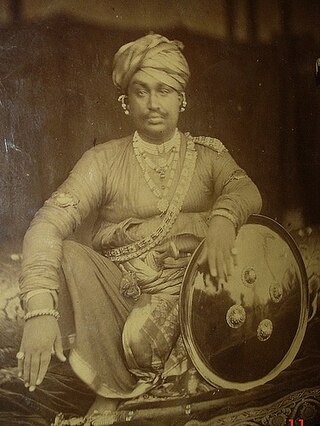
Maharajadhiraj Mirza Maharao Shri Deshalji II Sahib Bahadur was the Rao of Cutch belonging to Jadeja dynasty, who ascended the throne of Princely State of Cutch upon deposition of his father Bharmalji II by British. He reigned during his minority, under a Council of Regency, headed by Captain MacMurdo and composed of Jadeja chiefs.
Tera is a historic village in the Kutch District of the Indian state of Gujarat. It is in Abdasa Taluka, located 13 kilometres (8.1 mi) from the taluka headquarters, Naliya, and 84 kilometres (52 mi) from the district headquarters, Bhuj.
Tera Fort is one of the many forts of Kutch, Gujarat, India. It is situated in southwestern Kutch near the village of Tera in Abdasa Taluka.
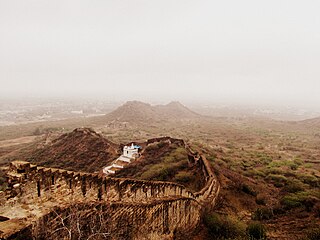
Bhujia Fort, also spelled as Bhujiya Fort, is a fort located in the outskirts of the town of Bhuj in the district of Kutch, Gujarat, India. The fort is built atop Bhujia Hill overlooking the town.

Cutch State, also spelled Kutch or Kachchh and also historically known as the Kingdom of Kutch, was a kingdom in the Kutch region from 1147 to 1819 and a princely state under British rule from 1819 to 1947. Its territories covered the present day Kutch region of Gujarat north of the Gulf of Kutch. Bordered by Sindh in the north, Cutch State was one of the few princely states with a coastline.
Manjal is a village in Nakhatrana Taluka of Kutch district of Gujarat, India. Nearby ruins of fort and temples of Paddhargadh is historical place associated with legendary Jakh Botera.
Rao Deshalji I was the Rao of Cutch belonging to Jadeja Rajput dynasty, who ruled Princely State of Cutch as a regent from 1718 1752. His son Lakhpatji confined him in 1741 and ruled as a regent until death of Deshalji in 1752.
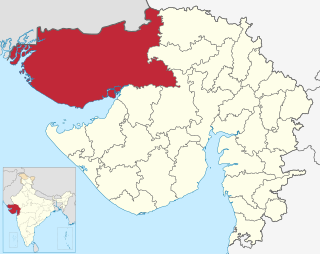
The history of Kutch, (kachchh) a region in the extreme west of the western Indian state of Gujarat, can be traced back to prehistorical times. There are several sites related to Indus valley civilization in region and is mentioned in Hindu mythology. In historical times, Kutch is mentioned in Greek writings during Alexander. It was ruled by Menander I of Greco-Bactrian Kingdom which was overthrown by Indo-Scythians followed by Maurya Empire and Sakas. in the first century, it was under Western Satraps followed by Gupta Empire. By fifth century, Maitraka of Valabhi took over from which its close association with ruling clans of Gujarat started. Chavdas ruled the eastern and central parts by seventh century but then came under Chaulukyas by tenth century. After fall of Chaulukya, Vaghelas ruled the state. Following conquest of Sindh by Muslim rulers, Rajput Samma started moving southwards to Kutch and ruled western regions initially. By tenth century, they controlled significant area of Kutch and by thirteenth century they controlled whole of Kutch and adopted a new dynastic identity, Jadeja.

The Shiva temple, Kera, also known as Lakheshwara temple of Kerakot, is located in Kera village near Bhuj of Kutch district in Gujarat, India. The temple was built during the reign of the Chaulukya dynasty (Solankis) in the later part of the 10th Century and is dedicated to Shiva. The temple has been subjected to severe earthquake damage during the earthquake of 1819 and the Bhuj earthquake of 2001. But the temple's spire, inner sanctum and the sculptures are still in an attractive condition.

Bhujia Hill or Bhujiyo Dungar is a hill located in the outskirts of the town of Bhuj in the district of Kutch, Gujarat, India. The Bhujia Fort built on the hill overlooks the town.